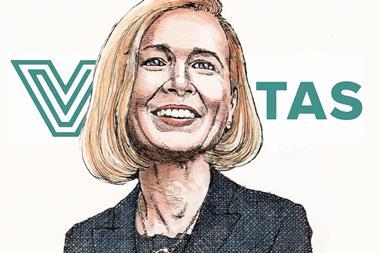Liam Kennedy asks Hugo Lasat, chief executive of Belgium's Amonis, about the challenge of running a pension fund after a career in asset management and private banking
Situated in an elegant townhouse close to Brussels's EU district, the headquarters of Belgium's second largest pension fund could be mistaken for those of a private bank. And Hugo Lasat, who was appointed chief executive of Amonis following senior positions in asset management, private banking and retail banking, sees strong connections between his current position and his previous roles.
The former CEO of Dexia Asset Management and member of the management board of Dexia is now in charge of a hybrid pension fund for the medical sector as well as for other liberal professions. The pension fund competes in the market against other pension savings vehicles. "This raises the importance for top-class client service," comments Lasat. "We are a market leader in the medical sector and have to compete, indeed, and that is important. It keeps us fit, competitive and slim. Costs have to be competitive, members services have to be outstanding and long-term performance has to be good."
The €1.1bn Amonis OFP (an OFP is the Belgian EU compatible pension funding vehicle) invests its assets partly directly, partly through the Amonis NV umbrella UCITS fund. This SICAV is open for investments to other institutions and even retail savers. The Amonis multi-asset portfolio, outsourced to external managers, could be compared with a fund of funds.
Lasat admits that his move to pension fund management has brought him additional insights regarding some aspects of asset and liability modelling.
"I thought as an asset manager that I had a good impression about asset liability management and how in detail and in practice it can influence the management of a pension scheme," he says. "In reality it differs from the concept we had as asset managers. That was interesting to discover, however, learning that a pension scheme should avoid steering only on the basis of an ALM and, as such, that this may not define 100% your asset composition. Other financial factors have to be taken into consideration and are equally as important as the ALM environment of the pension scheme."
Indeed, for Amonis, an annual ALM study, which will be conducted every two years in future, governs the overarching investment framework. Stress tests are also conducted and a risk committee, whose members include the actuary, CFO and the CEO, supervises the management of the pension scheme.
As a hybrid fund - Amonis defines itself as a cash balance scheme - the requirement is to deliver a pre-determined guaranteed return on past contributions and a return on new contributions. Currently set at 3% by the board of directors based upon the recommendation of management, that return is achieved through a portfolio that has been split between an income portfolio and a growth portfolio.
The income portfolio is designed to match liabilities, with investments made according to an internally designed yield curve that represents the fund's liabilities, and is managed on a forward 10-year rolling basis. Amonis matches its cash flows as closely as possible in the cash bond market and does not use derivatives. Lasat says there are currently no plans to change this approach: "We decided not to use derivatives and to go instead to the cash market. Every quarter, we review our portfolio construction, check congruence of movement of investments and liabilities. In addition, we add a forward-looking perspective. The results until now are very satisfactory with 99.7% congruence. Of course, you cannot match exactly but we can live with what we have achieved. In addition, we will build in a cushion in our income portfolio so the LDI portfolio produces a cash flow in excess of what we need."
The cash bonds are managed in collaboration with a small, dedicated Luxembourg asset manager, and information flow is high between the two entities. Amonis has more control and interaction than it would with a traditional segregated account: "It is a sensitive part of the portfolio and we want to exclude any mismatch versus our liabilities," as Lasat puts it.
In particular, given the dislocations in the yield curve, Lasat acknowledges that the worst thing to do at the moment would be to try to match liabilities 100% - "a textbook example of what not to do", he says. "You cannot build a long-term investment portfolio and achieve a satisfactory performance using a govvie yield curve that is influenced by an extraordinary temporarily loose monetary policy and which has little explanatory power in the real economy. Perhaps counter intuitive, but it would not be prudent."
Amonis put a cap on investments in the securities of governments in the riskier ends of the euro-zone at the end of 2009 - the so-called Club Med countries. "We took that decision at the end of last year when we were implementing our LDI portfolio. The decision was influenced by our internal asset allocation committee, and was actually supported by one of the external members of that committee. Lasat says this could be an illustration that the fund's governance and committee structure works well.
Amonis also believes the crossover segment of corporate bonds (BBB/BB) would be an attractive area for its portfolio, although these investment decisions are "sometimes difficult to reconcile with the objectives set by the board of directors", as Lasat puts it.
After the income - or LDI - portfolio was put together, the growth portfolio was constructed based on ALM, risk optimisation and beliefs on long-term trends in and behaviour of capital markets. It was implemented at the beginning of this year and Lasat says it has worked well so far.
But he also admits that there is no miracle recipe for devising a portfolio structured around such a minimum guarantee. "The only way to achieve long-terms results is to continue to aim for a well diversified portfolio composed of classic mix of asset classes," he says, pointing out that inflation protecting assets deserve special attention: "Some diversifiers, such as real assets, infrastructure and commodities are worthwhile to be represented in pension plan reserves."
Amonis's growth portfolio is structured as a classic balanced, multi-asset portfolio with plenty of equity risk premium, along with corporate bonds and alternatives, in recognition that Belgium's doctors and dentists will not retire comfortably with a 3% minimum annual return.
As of September 2010, Amonis was implementing a shift towards European equities, which Lasat says were found to be under-represented in the asset allocation following results of optimisation work and analysis carried out internally. The increased allocation of 25% of the total portfolio will be divided between indexed, small and mid-cap and high alpha components. UBS Global Asset Management will run the indexed portfolio and the small and mid-cap portfolio. Gartmore will run the high alpha mandate.
"The European equity asset class was under represented and until now, we were also benefiting from the strength of the dollar. Although the latter is not a reason for our asset allocation change," Lasat says, pointing out that the fund is aiming for two-thirds exposure to European equities and one-third non-European equities. This will largely be achieved in September, followed by cash inflows. At the the end of the year, Amonis will consider whether to increase its emerging market exposure, according to the CEO.
As a former chairman and CEO of an active asset management company, it is perhaps unsurprising that Lasat professes faith in active managers to add value. But he does add a caveat: "I also believe that pure beta or a passive approach has a role in terms of risk management and for achieving performance with a degree of certainty. On the other hand, I have seen that it has been possible to deliver alpha. The asset management industry has, in general, difficulty proving that it can add value, but I am convinced it can do so.
"It is for each pension fund to define how it wants to implement its asset allocation; implementing pure beta or looking for alpha or opting for a combination of both on different levels and depending on asset classes."
In alternatives, Amonis has rejected private equity: "We are too small to be able to obtain the transparency that I would like to see." But other than that, Lasat says his fund's size does not prevent effective diversification. Amonis believes in commodities as a diversifier and as a hedge against unexpected inflation. The fund invests via specific investment vehicles such as ETFs. As for hedge funds, Amonis has implemented a managed account with Key Asset Management. The strategy was implemented before Lasat joined the fund, but he says he would do it again this way.
"I like the transparency and the education process. The asset manager explains where the performance comes from and offers access to specific hedge fund managers, which is rare in the institutional hedge fund world," says Lasat. "The strategy has not brought the performance we thought it would and some strategies went south. In general, the industry has failed to prove its added value as an asset class, although this is not necessarily correct for some individual asset management companies. There is also room for improvement in transparency on fees and the industry has to accept that you cannot take away from the client such a large part of the risk premium that is earned - there must be a new equilibrium."
New strategies, like emerging market debt, are a possibility but not a given. Lasat believes he must be able to explain, in all circumstances at any time, performance to all members. "I am interested in new asset classes but I need to be able to explain strategy and performance without having to rely on a complex set of formulas. I want to deserve the confidence of all my clients or members."
Amonis is large in Belgian terms but relatively small in European terms. This means it occupies an interesting position - if it wanted to it could provide asset management and pension fund management services for Belgium's growing Vandenbrouke sector pension funds or for other pension schemes. On the other hand, Dutch fiduciary managers would see a €1.1 bn fund as a prime prospective client - although since its specialisation is with traditional defined benefit assets, it is hard to know how well it would manage a hybrid DC-oriented fund with no sponsor.
Here, Lasat repeats his opinion, and it is one of his favourite's topics, that there is a thin line between the asset management and pension fund sectors. "The pension 'executors' (such as APG) is evidence that the trend is there," he says. "Pension funds are moving onto the territory of the asset management companies and the biggest players will be able to offer services to others in the sector. We will also see a trend towards consolidation in the pension fund industry because of the increasing critical size necessary to run a pension fund effectively. In the case of Amonis, if people want to join us because they like us, we are more than happy to work together."
As Amonis grows, would it consider insourcing investment capabilities other than asset manager selection and portfolio monitoring? "Not all asset classes can be managed internally but there are some we could realistically internalise. At a certain point in time that question is a normal question to ask."












No comments yet